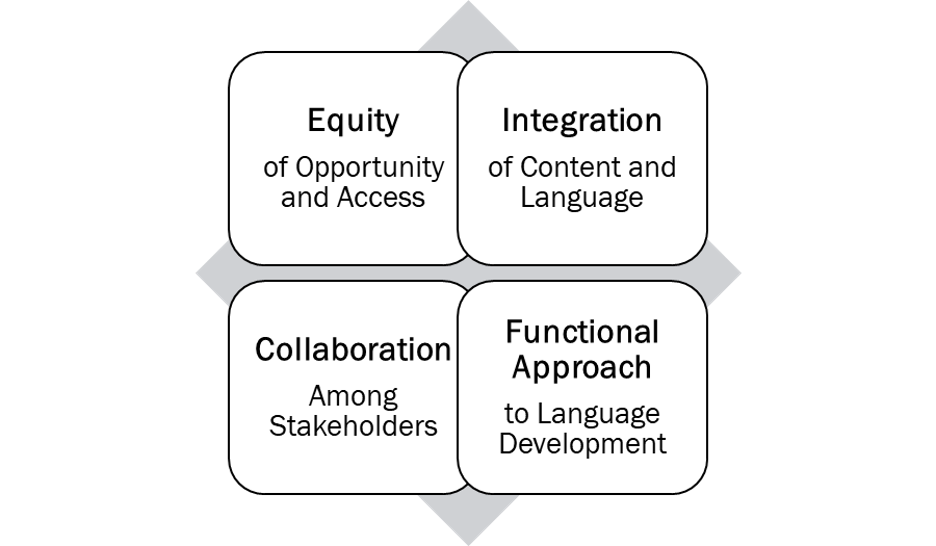With the publication of the WIDA 2020 English Language Development Standards Framework, teachers have experienced a renewed attention to making language visible through a functional approach to language development. This article uses sample elementary texts in mathematics and social studies to demonstrate this approach by identifying key language functions and features.
Keywords: WIDA 2020, functional approach, language features, language functions, elementary
Introduction
The new WIDA English Language Development Standards Framework (henceforth, WIDA Standards; WIDA, 2020) offers a renewed commitment to equity for multilingual learners (MLs) by building on students’ linguistic and cultural affordances, integrating content and language, promoting collaboration, and making language visible through a functional approach to language development (WIDA, 2020; Willner et al., 2021). The key language uses summarize language that is relevant across disciplines. These include narrate, inform, explain, and argue. Language expectations identify what students do with language to meet academic content standards and are further explained through the language functions and features, which are descriptions of some specific ways to meet these expectations.
This article uses sample texts in mathematics and social studies to demonstrate language functions and features from the WIDA 2020 Standards (WIDA, 2020). We discuss language expectations for students to meet content standards and the key language uses that summarize the most prominent language used across disciplines. Drawing on a functional approach to language development (de Oliveira & Jones, 2023; Fang & Schleppegrell, 2008; Schleppegrell, 2004), we use the new metalanguage of the WIDA Standards to identify language features that could be the focus of instruction for MLs.
WIDA 2020 English Language Development Standards Framework
The WIDA Consortium is a member-based organization made up of 41 U.S. states, territories and federal agencies, dedicated to the research, design and implementation of a high-quality, standards-based system for K-12 MLs. WIDA recently published the WIDA English Language Development Standards Framework, 2020 Edition, Kindergarten-Grade 12 (WIDA, 2020). Language functions are common patterns of language use that showcase particular ways students might use language to meet the purposes of schooling. For example, a series of language functions is associated with the process of constructing fictional narratives, informing peers of newly gained knowledge, explaining phenomena, or engaging in scientific argumentation (WIDA, 2020, p. 28). Language features include types of sentences, clauses, phrases, and words (WIDA, 2020, p. 29) that enact those language functions. Together, the language functions and features form a dynamic and illustrative set that shows some of the ways language works in service of content learning. (See Figure 1 for an illustration of the ‘big ideas’ in the WIDA Standards.)

A functional approach to language development
A functional approach to language development, one of WIDA’s (2020) Big Ideas, is based on systemic functional linguistics (SFL) (Halliday & Matthiessen, 2014), a theory of language that enables a focus on meanings and provides a metalanguage for talking about the meanings in the choices authors make (de Oliveira & Westerlund, 2021). The goal of implementing a functional approach in content classrooms with MLs is to enable teachers to identify language patterns in order to help MLs see how language works. It also allows for analysis of texts in multiple contexts. Any time that we use language, we are simultaneously presenting some kind of content, enacting a relationship with a listener or reader, and organizing this content in some way by building a cohesive message (de Oliveira, 2023; de Oliveira & Schleppegrell, 2015). These three areas of meaning – presenting content, enacting relationships, and constructing a cohesive message – help us examine language closely. Teachers and students explore texts as they are written, without simplification (de Oliveira, 2023). In implementing a functional approach (see Figure 2), we analyze different discourse patterns within each area of meaning and make explicit to teachers:
- how content and information are presented in a text
- how an author/speaker relates to readers/listeners
- how an author/speaker organizes the content in cohesive ways

Sample annotated text analysis
We use sample texts in mathematics and social studies to exemplify some language functions and features.
Mathematics
In mathematics, we selected two word problems, both from a fourth-grade mathematics textbook entitled Eureka Math (Great Minds, 2015). In the fourth grade Eureka Math book, Module 1 lesson 1, the lesson’s main focus was on interpreting a multiplication equation and incorporating comparisons. During the lesson, students were asked to solve the following word problems:
Matthew has 30 stamps in his collection. Matthew’s father has 10 times as many stamps as Matthew. How many stamps does Matthew’s father have? Use numbers or words to explain how you got your answer.
Jane saved $800. Her sister has 10 times as much money. How much money does Jane’s sister have? Use numbers or words to explain how you got your answer.
Analysis
As evident in the word problem and directions, students were given the opportunity to choose how they represented their answers, using words or numbers. This corresponds with the various ways that MLs are developing their language in math as they learn to express themselves in multimodal ways (WIDA, 2020). When looking at the standards for mathematics, mentioned in WIDA (2020), MLs should be able to: analyze problem-solving steps (explain-interpret), state their reasoning for generating a solution and share their solutions with their teachers and peers (explain-expressive), and justify solutions with patterns or rules (explain-expressive).
In Appendix A, these word problems were analyzed to determine how language functions and which features are present. For this text and the key language use explain in mathematics, an analysis of the language functions and features supports access to understanding and solving the word problems.
Identify concept or entity
In these word problems, generalized nouns were used to introduce concepts and processes; stamps and money. Specific mathematical terms were also used to introduce the operation that would be used in the word problems. The word times has multiple meanings and in this example it means the verb to multiply. Relating verbs are used to show who has and have the stamps that will be compared to answer the question: How many stamps does Matthew’s father have?
Analyze plan for problem solving steps
Finally, word problems often include imperative statements to direct the reader to action, to solve a problem. In these examples the word use again informs the reader what the response should contain. How many and how much are quantity determiners and tell the reader how to format the response.
Social Studies
The second text analyzed was extracted from a second-grade social studies textbook, Chapter 2, Our Changing Lives (Wallenstein, 2017). It is about a world of change from 1600 to today in population, jobs, transportation, and communication. The key language use of the selected text is Explain, so we will use the WIDA Standard 5 for Grades 2-3 Explain (see WIDA, 2020, p. 96) to guide the analysis.
Think about life in your community. The way people live today is very different from the way people lived 200 years ago. Back then there were no iPads or laptop computers. There were no electric lights, airports, six-lane highways, or huge skyscrapers. Refrigerators had not been invented to keep food cold, and a trip from Virginia to the Pacific Coast took months. Many people never traveled farther than a day‘s walk from the place they were born. (Wallenstein, 2017, p. 22)
Analysis
Introduce phenomena or events
In this social studies text (analyzed in full in Appendix B), the author uses an imperative statement to speak to the reader directly as a way to introduce our changing lives. For example, the first sentence of the text, “Think about life in your community” begins with the verb think, and uses the second person your to give instructions directly to students. The prepositional phrases and adverbials of time are used to contextualize phenomena or events. For example, the use of today, 200 years ago, back then, and months. The third language feature for describing phenomena in the text is the use of relating verbs. See, for example, “The way people live today is very different.” The verb is is a relating verb. More examples like were can be found in the following two sentences: “Back then there were no iPads” and “There were no electric lights.” The verb form of be is used here to show the way people lived 200 years ago. There is a useful sentence structure that teachers can share with students while unpacking the text with them, There were no + noun (“relating” process be + noun structure). The last language feature to introduce phenomena is the use of single nouns to represent abstract concepts. For example, the single noun community in the first sentence.
Describe components, order, causes, or cycles
The author uses adverbials of time as connectors to establish relationships among ideas, for example, today, 200 years ago, and back then. The next language feature is the use of expanded noun groups that include adjectives to answer questions about how many, and what something is like, for example, laptop computers, Pacific Coast, electric lights, and six-lane highways. The last language feature is the use of past tense verbs to describe events. For example, were, had not been invented, took, and traveled are used here to provide facts from 200 years ago.
Other language features are found while analyzing the text, for example, the use of comparison structures different from, farther than to state the differences between 200 years ago and today.
Conclusion
Understanding the role of language in teaching and learning with specific content areas requires attention to how language structures exist through a functional approach (de Oliveira, 2023). This analysis demonstrates the process of language analysis using two sample texts to highlight specific language features and explain their functions. Language analysis like this can support teacher clarity and instruction for students in turn to demonstrate their understanding through clear and consistent language patterns.
The sample texts in mathematics and social studies selected show only a certain number of language functions and features. Drawing on a functional approach to language development, we used the metalanguage of the WIDA Standards to identify language features to present the analysis showing an example of how teachers can analyze texts to determine the most prominent language that could be the focus of instruction for MLs.
References
de Oliveira, L. C. (2023). Supporting multilingual learners’ academic language development: A language-based approach to content instruction. Routledge.
de Oliveira, L. C., & Jones, L. (2023). Teaching young multilingual learners: Key issues and new insights. Elements in language teaching. Cambridge University Press.
de Oliveira, L. C., & Schleppegrell, M. J. (2015). Focus on grammar and meaning. Oxford University Press.
de Oliveira, L. C., Smith, S. L., Axelrod, D., Diaz, E., & Vicentini, C. (2021). Supporting academic language development for multilingual learners across content areas through the identification of textual features. Journal of Narrative and Language Studies, 9(17), 227-242. Retrieved from https://nalans.com/index.php/nalans/article/view/431
de Oliveira, L. C., & Westerlund, R. (2021). A functional approach to language development for dual language learners. Journal of English Learner Education, 12(1). Retrieved from https://stars.library.ucf.edu/jele/vol12/iss1/2
Fang, Z., & Schleppegrell, M. J. (2008). Reading in secondary content areas: A language-based pedagogy. University of Michigan Press.
Great Minds. (2015). Eureka Math, Grade 4. Retrieved from https://www.engageny.org/resource/grade-4-mathematics
Halliday, M. A. K., & Matthiessen, C. M. I. M. (2014). An introduction to functional grammar (4th ed.). Routledge.
Schleppegrell, M. J. (2004). The language of schooling: A functional linguistics perspective. Lawrence Erlbaum Associates.
Wallenstein, P. (2017). Our world: Our United States. Five Ponds Press.
WIDA. (2020). WIDA English language development standards framework, 2020 edition:kindergarten-grade 12. Board of Regents of the University of Wisconsin System. https://wida.wisc.edu/teach/standards/eld
Willner, L.S., Kray, F. M., & Gottlieb, M. (2021). What’s the same and what’s been updated in the WIDA English language development standards framework, 2020 edition? MinneTESOL Journal, 37(2). https://minnetesoljournal.org/whats-the-same-and-whats-been-updated-in-the-wida-english-language-development-standards-framework-2020-edition/
Appendix
Appendix A & B: Annotated math and social studies texts












